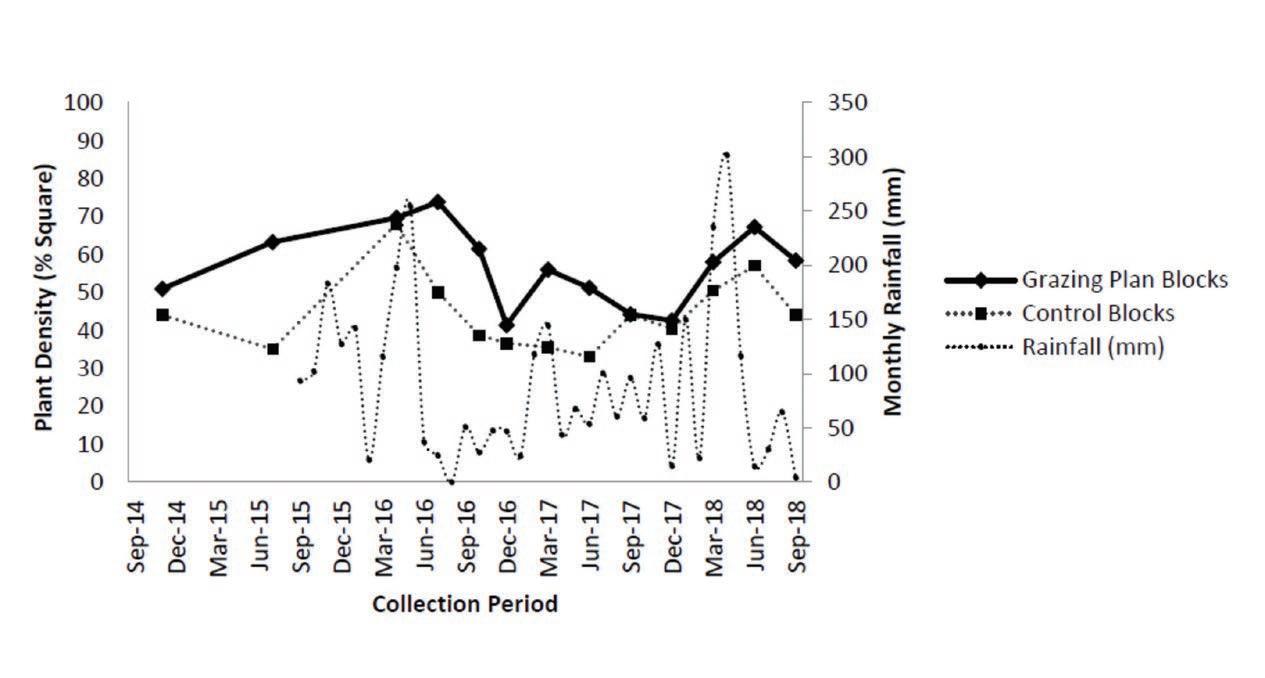
10 minute read
ANN ADAMS
Enonkishu Conservancy— A Holistic Approach to Land Conservancy
BY ANN ADAMS
On the northern edge of the Maasai Mara-Serengeti ecosystem sits the 6,000-acre Enonkishu Conservancy. The name for the conservancy was developed from the local Maa language and translates to “Place of Healthy Cattle.” The habitat of this area includes wooded acacia savannah with open plains on flat plateaus, riverine acacia forest and rocky hills which provide a diverse habitat for browsing and grazing ungulates and predators. The conservancy was first developed in 2009 by Tarquin and Lippa Wood who are also the founders of the Mara Training Centre and the inspiration behind all the enterprises that help fund Enonkishu.
The land had been under intensive crop production and overgrazed by livestock and the forest and wildlife habitat that remained was under threat of being cleared for more cultivation. Through various fundraising efforts, Tarquin and Lippa and the resident Maasai community created the Enonkishu conservancy. They wanted to use livestock as a way to improve the health of the land and the wildlife habitat. They had heard about Holistic Management from numerous sources and they reached out to the Savory Institute for help. The Savory Institute provided the initial training through Holistic Management educator Richard Hatfield. With support from WWF they managed to raise funding to train the community in Sustainable Rangeland Management on a regular basis over a two-year period. Enonkishu partners with the Mara Training Centre, which is now a Savory Hub, to help train other conservancy communities in better livestock and rangeland management using Holistic Management.
There are 32 conservancy members from the local Maasai community, 12 of whom own livestock and have an agreement with Enonkishu management to care for their herds in exchange for land lease fees. Additionally, Enonkishu hires herders, night guards, maintenance workers and a herd manager to provide the management of the livestock herd so that the holistic grazing plan can be implemented. Recent monitoring has shown that the grazing plan areas are averaging a 14% increase in productivity and land health as compared to the control areas. Developing Management and Monitoring Protocols Besides the Woods, the leadership team for
Enonkishu consists of manager Rebekah Karimi, Forage Assessment Manager Musa Kiseer, and Albert Cheruiyot, a ranger dedicated to the management of data generated quarterly. The leadership team is all ably assisted by numerous staff, herders, rangers, and volunteers. Rebekah first visited the Maasai Mara as part of a study abroad program with Michigan State University. Wildlife and livestock both benefit from Holistic Management in Enonkishu Conservancy. She had studied conservation biology and was looking for job in Kenya because she was a Kenyan citizen and wanted to make a larger contribution to conservation than what she could find in the USA. She returned to Kenya in June 2017 to begin managing Enonkishu as she
Plant density measured as percentage of quadrat covered in plants throughout the duration of the biomonitoring shows higher plant densities in the grazing areas versus the control areas.
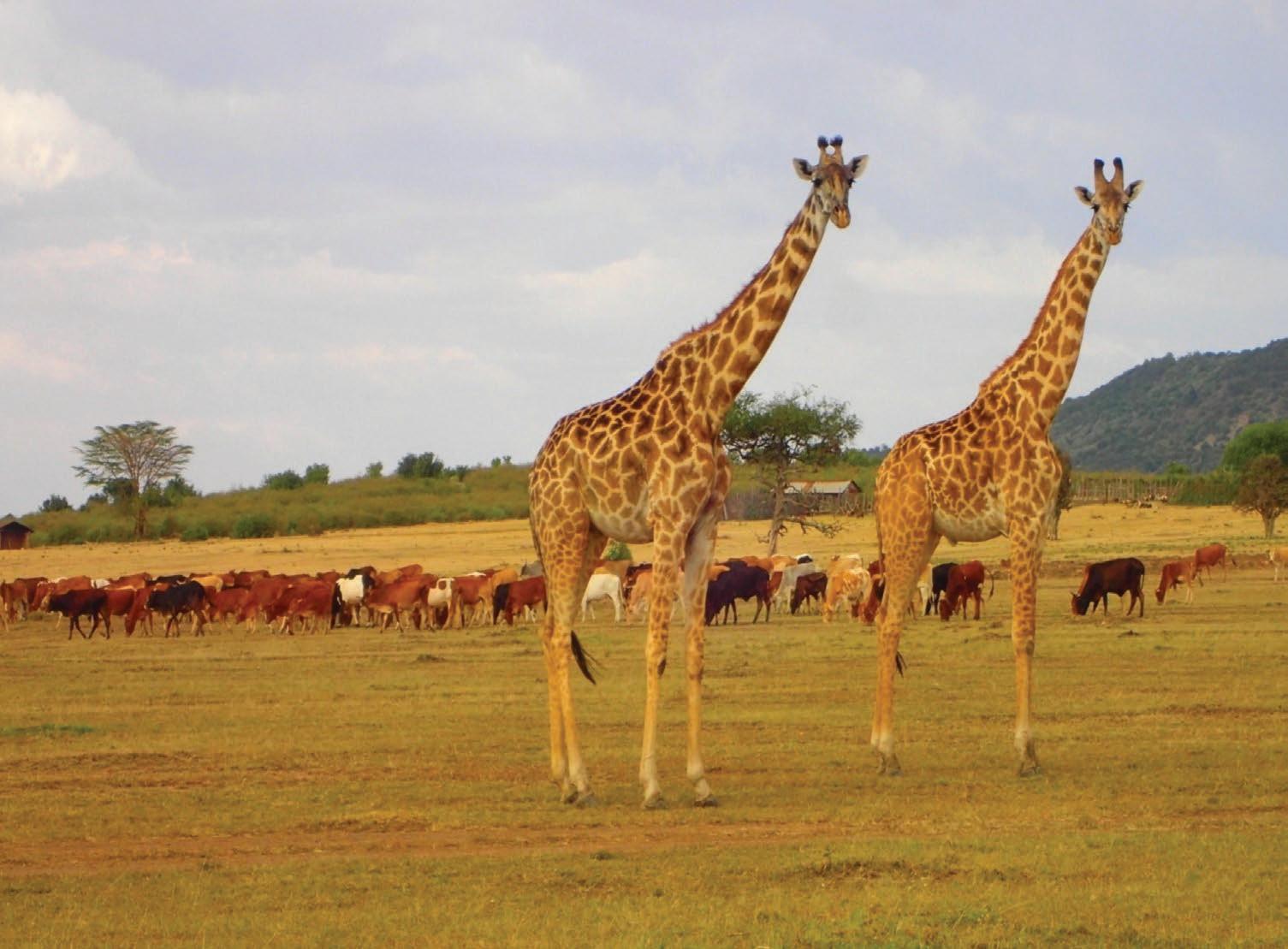
was attracted to the vision of the conservancy.
By that time, Enonkishu had been implementing Holistic Management since 2014. They had begun collecting biomonitoring data in 2014, but there were some data collection consistency issues in those early days. However, by 2016 they were monitoring their 14 transects each quarter. Each transect consists of five one-meter squares, and they evaluate indicators such as organic matter, plant cover, plant diversity, and animal activity. In addition, they have implemented the Ecological Outcome Verification designed in partnership with the Savory Institute. They have found the best time of year to conduct the intensive monitoring is prior to the influx of wildebeest and other ungulates which usually come through the conservancy around July.
Likewise, Enonkishu was struggling with consistent implementation of the grazing plan. “But in January 2018, we decided to hire our own herders,” says Rebekah. “Before that time, we advised the herders, but they worked for the conservancy members who owned the livestock. Once we hired the herders and put all cows into one herd managed collectively, that made all the difference. We could actually see the difference on the land right away. We found that every quarter we had a 2–3% increase in forage production, and that difference continues to grow each quarter, regardless of rainfall.”
In addition to managing the cattle belonging to the conservancy members, Enonkishu has raised donations to purchase 157 heifers to use for rangeland restoration, as well as improve the genetics of the local cattle by crossing the local Zebu cows with Boran bulls. With improved genetics the effort to engage the community in viable ranching enterprises rather than subsistence farming is also more likely. The cattle purchases are also part of the “Herds for Growth” project which will help Enonkishu diversify revenue, and increase the value and quality of the local meat. The idea is that this project will serve as an example to neighboring conservancies. With time, Enonkishu hopes to donate cows to these conservancies and set up grazing plans and implement monitoring and training protocols as well. The conservancy has a big vision of expanding its reach in the future by managing monitoring operations in neighboring conservancies (Olchorro Oiroua

Cattle have sustained adequate condition even with three months of no rain in 2018.
CONTINUED ON PAGE 6

Conservancy which has 13,000 acres and Lemak Conservancy which has 17,000 acres), which have no physical barrier and therefore share wildlife and wildlife habitat.
A key component to effectively protecting the livestock from the numerous large predators that call Enonkishu home is the mobile bomas (corrals) which are strategically placed in areas of the conservancy where there is erosion and bare ground. This additional animal impact has helped improve ecosystem function in those areas. With improved grazing planning has come increased wildlife numbers which also means more revenue for the Maasai through increased tourist traffic wanting to view the wildlife.
Enonkishu employs nine local Maasai herdsmen who have been trained in Holistic Management and understand the importance of their work to the outcomes desired on the land by the conservancy and the community as a whole. The herders meet to discuss the grazing plan and how they need to adapt to changing circumstances as they arise. They understand they are managing the cattle for the whole of the conservancy—the soils, plants, animals (wildlife and livestock), and people. For example, the presence of lions in one area required the herders to move the herd to another grazing area because the cattle did not want to graze in
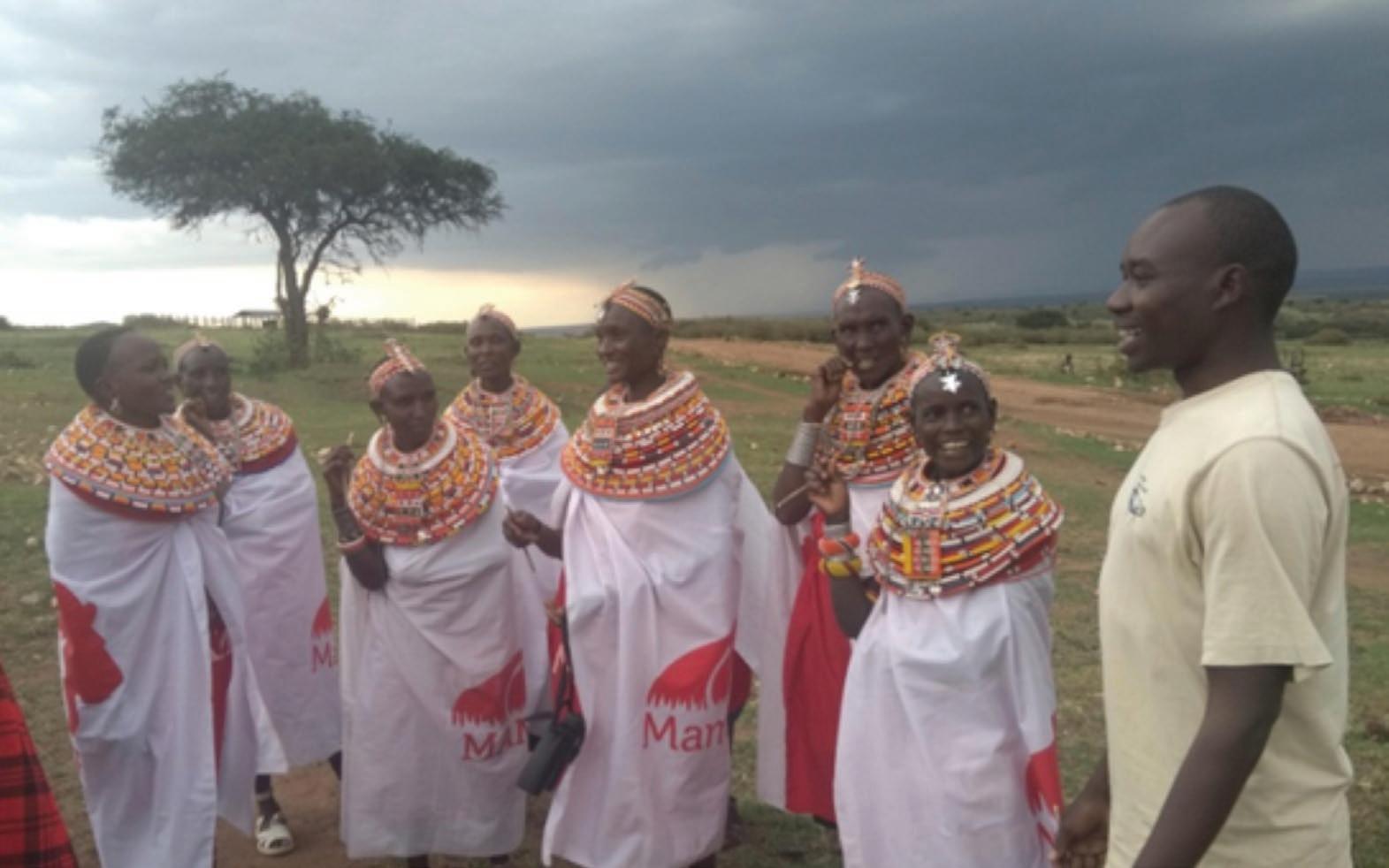
the area that had been planned.
When the conservancy was newly formed, landowners believed that the maximum amount of cattle the land could sustain was 300. However, over the past three years of better management practices, with the improved pastures and ground cover, this number has increased to a cap of 800. The cooperative revised their former strategy, determining that more goats could be helpful in slowing down bush encroachment, but the total number of SAU in goats will be capped at 500. Rainfall is 700–1000mm (28–40 inches) per year, but vastly fluctuates year to year.
In order to be a member of Enonkishu conservancy, Maasai must own land within the conservancy boundaries and abide by certain parameters like capping livestock numbers to an appropriate carrying capacity identified by the conservancy with its grazing plan and also abiding by the rules of no wood harvesting or the development of permanent structures or fences. While, Enonkishu leases land from the 32 conservancy members, livestock-owning members then pay a management fee for each cow the team manages. This fee is deducted from the land lease payment. Monies are used to pay the herd manager and to pay two maintenance works to move the mobile bomas and maintain the water troughs and cattle dip. The focus is to preserve natural springs and keep livestock out of those natural sources so the water troughs are critical. Enonkishu has nine grazing blocks/paddocks and there are four human-made water sources.
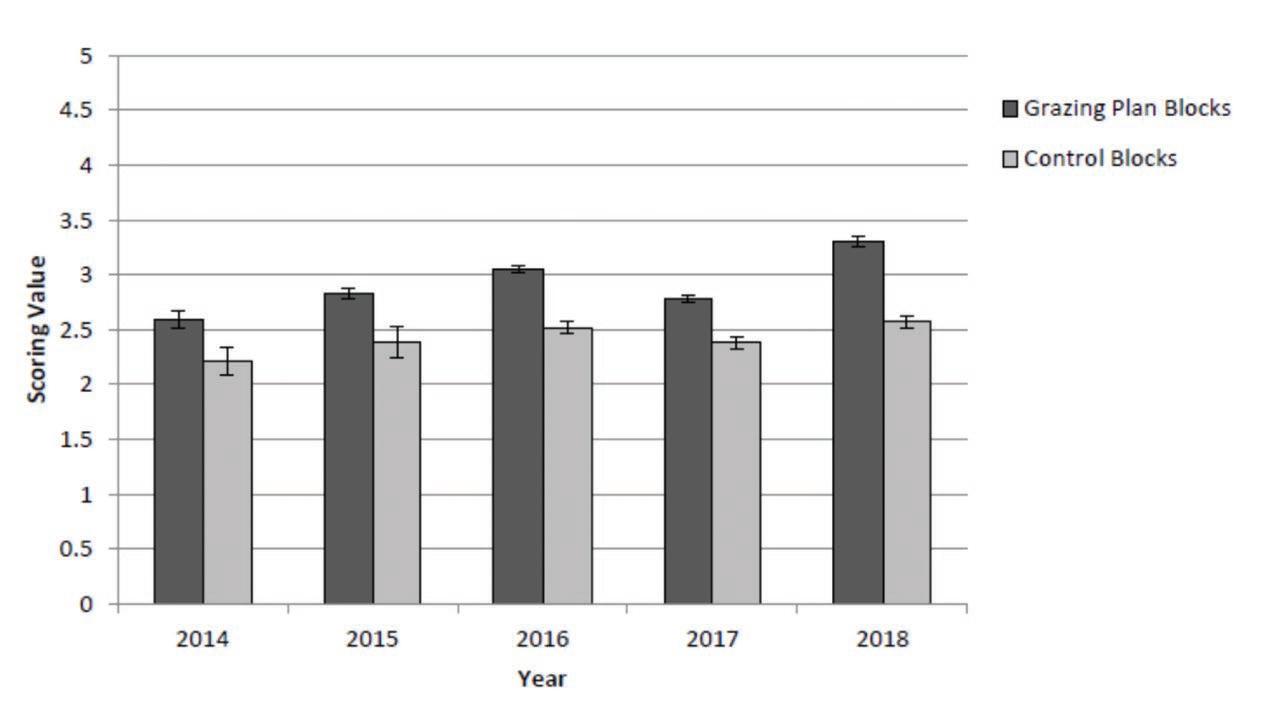
The data for comparing the grazing versus control areas show that the average score of up to 19 biological monitoring parameters throughout 13 bio monitoring sessions is greater in the grazing areas. The years 2014 and 2015 had one session each, while 2016 and 2017 had four quarters of data and 2018 includes three quarters’ sessions. Error bars indicate standard error of data collected each year.
Mara Training Centre’s Monitoring Officer, Musa Kiseer, teaching representatives from the Mama Simba branch of Ewaso Lions about sustainable rangeland management during a conservancy visit.
Over 25 different wildlife species live and/ or travel through Enonkishu including impala, wildebeest, zebra, giraffe, warthog, gazelles, eland, elephant, topi, hartebeest, cape buffalo, dikdik, waterbuck, spotted hyena, cape bushbuck, hartebeest, jackal, klipspringer, leopard, various monkeys, lion, fox, cheetah, hyena, hippopotamus, and more frequent sightings of African wild dog. The diversity and quantity of these species have continued to increase as the land has improved. Rangers patrolling the area complete counts on a daily basis using both handwritten forms as well as wildlife counting apps on smartphones.
The staff and community are excited about the increase of all species (including predators) as this ecosystem comes to life. But having these predators in close proximity to domesticated livestock certainly has its challenges. The mobile bomas must be placed correctly so if there is a lion attack in the middle of the night, the cattle can’t breakdown the fencing. Likewise, night-time herders have found that more herders with brighter flashlights help to keep the lions away. Last year, blinking predator deterrent lights were also implemented
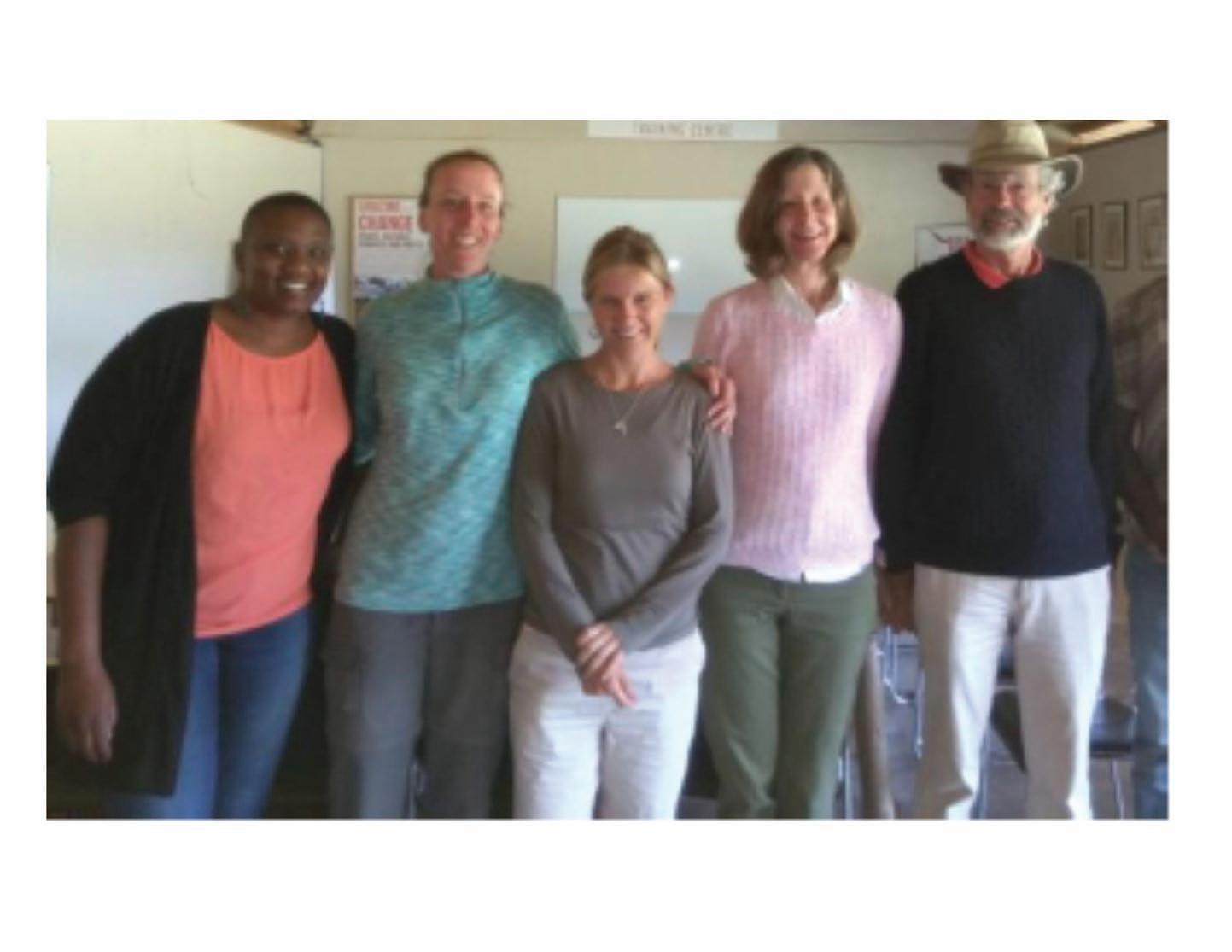
to further protect the livestock at night. Unfortunately, these lessons have been learned at the loss of livestock. Last year, eight cows were lost in a lion attack on a mobile boma. The boma had a flat side in its construction which resulted in the frightened herd knocking one side down, which then allowed the lions to take down the cattle as they left the protective enclosure and ran wild in the night. Efforts have been taken to emphasize the importance of proper construction of the bomas with herders and night guards also
inspecting daily to ensure the security of the herds. Management also hired an additional night guard to ensure that there are always two on duty. With these measures in place, additional visits by lions did not lead to further cattle losses. Rebekah Karimi (second from left) and Lippa Wood (second from right) with visiting researchers at Enonkishu.

Maasai herders are employed by Enonkishu. Here they are performing a traditional dance for some recent visitors. Partnerships for Success
Enonkishu depends on the partnership of many entities. For example, in November 2017, a team from Michigan State University visited the Mara Training Centre and trained Albanus
Mutiso and Musa Kiseer on the monitoring protocols now being used to measure rangeland health. They also partner with the
Kenya Wildlife Services which help provide wildlife expertise and ranger support for dealing with poaching pressure.
Likewise, in 2018, a team of researchers affiliated with the Serengeti Lion Project and the Whole Village Project came to learn about the Enonkishu model of promoting the coexistence of livestock and wildlife. They worked with Enonkishu to place camera trap grid transects and learn how to monitor the impact the Mara Training Centre and
Enonkishu is having on the community.
The conservancy’s four water points were constructed using funds donated by the
MAMASE (Mau Mara Serengeti Sustainable
Water Initiative) in 2017. The result of having these water points that allow cattle to drink away from eroded areas is that banks along the Mara River have begun to heal and wetlands within the conservancy have expanded. In addition, the MaMaSe project funded the refurbishment of a cattle plunge dip.
Of course, the greatest partnership is with the local Maasai community, engaging them as conservancy members, rangers, herders, and staff. Given that the Maasai have a culture of livestock husbandry and a desire to sustain the






